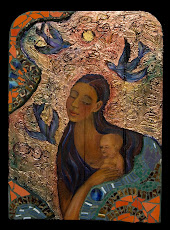Cristina Acosta ©2005, 2006, 2007, 2008
My grandmother (abuelita) Catalina Maria Ortiz Acosta's parents were born in New Mexico. She made chili sauce in the New Mexican style, a sauce of mostly puréed, dried chilies with spices. This sauce is the backbone of many Hispanic dishes.
Catalina was an artist who believed that anything worth knowing came at a price, and this sauce was her specialty. She was in her seventies before she would give me this recipe. In exchange for the recipe she insisted I wash every downstairs window of her house. While I scrubbed and polished, she sat in the backyard patio of her home in Playa del Rey, California, by the sea near Los Angeles threading a ristra of chilies from a new box of chili peppers that had arrived from New Mexico. After finishing a few windows I’d stop to visit with her and she’d tell me a little bit more about her recipe. It was certainly worth the effort.
If the sauce is too picante (hot), you can cut the heat by adding a can of stewed tomatoes or a thick tomato sauce to the blender. This suggestion would have been frowned upon by my abuelita who insisted that a proper chili sauce never included tomatoes. Nonetheless, if the mildest chilies are too hot for your taste, this method works.
My abuelita’s original recipe used to take hours when prepared with a food mill. I’ve adjusted the chili sauce recipe for quick and easy preparation. Use a powerful blender such as a Vita-Mix for best results.
Cristina's Traditional Red Chili Sauce
Tools: 1 ½ qt. or larger saucepan with lid. Powerful blender. Stove top.
Yield: Aprox. 3 ½ – 4 cups of sauce
Ingredients:
- 1 t. to 1 T. ground cumin
- 1 T. dark cocoa powder (unsweetened)
- ½ t. sea salt
- 2 cloves garlic, peeled
- ½ large onion (aprox. ½ cup) peeled. (use your favorite flavor of onion)
- 3 oz net wt. package of dried chilies: Use Chili California OR New Mexican OR Pasilla OR experiment with mixing varieties.
- 3 cups water or broth.
- With scissors cut off the tops of the dried red chilies and pour out the seeds. (Don’t worry about getting them all out.)
- Rinse the dried chilies briefly to dust them off.
- Put them in the sauce pan with the water, garlic and onion.
- Bring to a boil then cover and simmer for 15-20 minutes.
- In the blender put the cumin, salt and cocoa powder. Add the hot chili mixture including the water. Put the lid on the blender and slowly “step-up” the speed of the blender from low to high. (Never start a hot mixture on high as it may explode out of the top of the blender.) Process the mixture on high for approx. 3 minutes or until very smooth.
This versatile sauce is ready to serve. It freezes beautifully. Use it over tamale pie, as an enchilada sauce, base for chili soups or over fried eggs and omelets. It's the key ingredient to Carne Adovada, a traditional New Mexican pot roast slow cooked in the red chili sauce.
Experiment with the sauce by adding ingredients such as: wine, dried fruits such as raisins, apricots, plums, ground toasted nuts or seeds (about ½ cup) , sweet chocolate and cinnamon.
Note: for a thicker sauce, add a few more chilies or decrease water a little.
Happy Cooking -- Cristina
Vitamix is more than just a big blender. It's a powerful tool in the kitchen and a powerful tool for a healthy diet. Vitamix recipes and techniques enable you to eat up to 10 fruits and vegetables along with whole grains that are recommended by experts and you'll love the ease and simplicity of the Vitamix. |






















